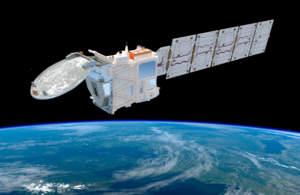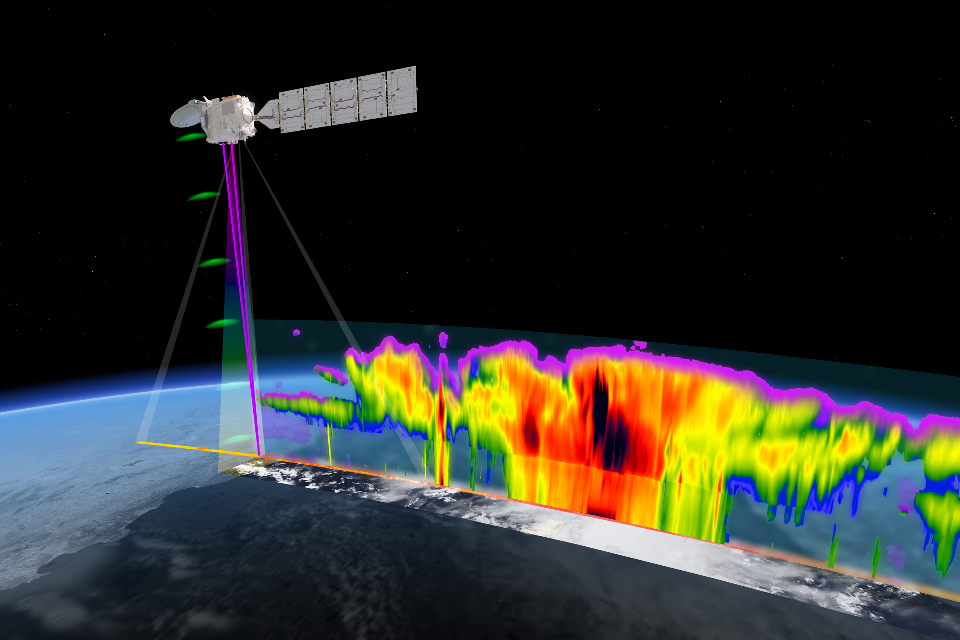EarthCARE
A mission to better understand the role of clouds and aerosols in regulating Earth’s climate.

Artist's impression of EarthCARE mission. Credit: ESA/ATG Medialab
EarthCARE (Earth Clouds, Aerosols and Radiation Explorer) is a joint European-Japanese mission, with more than 20 UK organisations involved. The mission was launched successfully on 28 May 2024.
The mission is the brainchild of Professor Anthony Illingworth, from the University of Reading. It should lead to more reliable climate predictions and better weather forecasts.
EarthCARE was developed by the European Space Agency in co-operation with JAXA, the Japanese Aerospace Exploration Agency. It will use four cutting-edge instruments to enhance our understanding of how clouds influence the climate system.
The EarthCARE satellite is the sixth, and most complex, Earth Explorer mission of ESA’s Living Planet Programme. Earth Explorers are focused research missions dedicated to specific aspects of our planet’s environment carrying onboard leading-edge technologies, with the overall emphasis on learning more about the interactions between components and the impact that human activity is having on natural processes.
Aerosols, like dust and smoke, play a role in the formation of clouds and their properties. Clouds control the production of rain and convection influences stratospheric humidity. The observations of EarthCARE will lead to more reliable climate predictions and better weather forecasts.
Mission facts
On 27 May 2008, the European Space Agency and Astrium GmbH signed a contract worth €263 million to provide the EarthCARE satellite with Astrium GmbH responsible for the satellite’s design, development and integration.
EarthCARE has been designed with the specific scientific objectives of measuring cloud-aerosol-radiation interactions so they may be included in climate and weather forecasting models.
The satellite launched on a SpaceX Falcon 9 rocket from Vandenberg Air Base in the USA on 28 May 2024.
It will travel in a Sun-synchronous 393km polar orbit, completing an orbit every 90 minutes.
EarthCare weighs just over two tonnes (2,200kg), measures 17.2m in length with its solar array deployed, and is expected to operate for a minimum of three years.
Technology

Illustration of EarthCARE gathering data. Credit: ESA/ATG Medialab
EarthCARE employs high-performance lidar and radar technology that has never been flown in space before, with the objective to deliver unprecedented datasets to allow scientists to study the relationship of clouds, aerosols and radiation at accuracy levels that will significantly improve our understanding of these highly variable parameters.
The satellite weighs about 1.7 tonnes and carries 4 instruments: an Atmospheric Lidar, a Broad-Band Radiometer and a Multi-Spectral Imager developed by ESA, and a Cloud Profiling Radar developed by JAXA.
ATLID (Atmospheric Lidar) and CPR (Cloud Profiling Radar) will provide vertical profiles of cloud and aerosol structures.
The multi-spectral imager (MSI) will enable different cloud types and aerosols to be distinguished and will provide the meteorological/optical framework of the actively sampled profiles.
The Broad-Band radiometer (BBR) will provide broadband radiances at the top of the atmosphere that will serve as a consistency test of the retrievals of cloud radiative properties from the active instruments.
UK involvement
Airbus Defence and Space UK was responsible for the full satellite base platform as part of the core team.
Thomas Keating designed and built the quasi-optical multiplexer and antenna feed for JAXA’s Cloud Pulse Radar though Airbus, providing a power monitoring scheme to track the power levels transmitted by the EIK 94 GHz microwave tube.
Surrey Satellite Technology (SSTL) supplied the MSI instrument which includes a VNS camera (covering the visible, near-infrared and shot-wave infrared bands of the electromagnetic spectrum) as well as a camera covering the thermal infrared band.
The MSI Instrument Control Unit is located within the interior of the satellite and was developed by Thales Alenia Space UK (TAS UK).
TAS UK also supplied the Broadband Radiometer instrument, while RAL Space supplied the Broadband Radiometer Telescope Assembly. Teledyne e2V were responsible for the detectors on the ATLID instrument.
GMV-UK, Telespazio UK & CGI UK are all involved in ground segment activities, while CGI produced onboard software for the ATLID, MSI and BBR instruments.
Dr Robin Hogan, from the European Centre for Medium-Range Weather Forecasts and the University of Reading, is Co-Chair of the ESA-JAXA EarthCARE Mission Advisory Group.
Dr Kamil Mroz, from the National Centre for Earth Observation (NCEO) and University of Leicester, led a group that developed an algorithm for the Cloud Profiling Radar to provide properties of clouds and precipitation, e.g. size of raindrops, intensity of rain.
Dr Shannon Mason, ECMWF, NCEO and University of Reading, developed an algorithm that combines measurements from all four instruments to estimate properties of clouds, aerosols and precipitation.
Learn more about EarthCARE from ESA.
Updates to this page
-
Updated following the launch of the mission
-
Added target launch date and details of academic involvement.
-
Information about Thomas Keating's involvement has been added to the UK involvement heading, and the expected launch date has been added to the mission facts heading.
-
Information about mission and UK involvement updated.
-
Launch date updated to 2020.
-
First published.